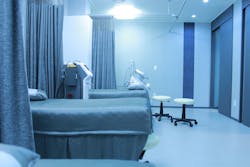A study undertaken by Pacific Northwest National Laboratory (PNNL) researchers surveyed 138 representatives of medical-surgical nursing staff as to environmental lighting factors and needs in med-surg patient rooms. Four hospital sites were compared, with various combinations of lighting equipment, controls, and number/form factor of fixtures. I’m not going to summarize the site differences here; you can get the details of the environment-of-care specifications in the PNNL report, available as a PDF.
An earlier analysis focused on the quantitative aspects of the questionnaire, whereas the current work analyzes open-ended responses that, to my understanding, more closely reflect how a lighting designer/specifier might query the end-user customer for a lighting project in a healthcare setting.
The open-ended responses allowed the researchers to characterize themes of importance to the survey respondents, along with sub-categories of accessibility, light levels (both natural and electric), and more.
The three questions that were evaluated in the current results were:
- For a typical patient room in which you work, what do you think is the best thing about the lighting?
- For a typical patient room in which you work, are there any changes to the lighting that you think would help you in performing your professional duties, or that would have a positive effect on your work experience?
- For a typical patient room in which you work, are there any changes to the lighting that you think would help the patients have a more positive experience— based on your observations and/or patient feedback?
A key theme that emerged from the responses was control, across all four facilities under the study. “[D]espite the differing standards in the four facilities, nurses generally perceived a sense of control, for themselves and their patients, to be most important, followed by adequate daylighting (preferably through windows),” the report stated.
With regard to what could improve performance of duties and work experience, the researchers observed that “It would seem, as it did in our previous study with the same sample measuring quantitative aspects, that most nurses desire better control in order to increase or decrease light level, indicating that their perceptions of brightness and control are very closely related as attributes that ought to be optimized in patient rooms.”
Again, with regard to the patient experience, survey participants revealed that control of lighting, mainly with regard to light levels for both performance of tasks to the patients’ benefit as well as dimming capability for their comfort, was important to that experience. One of the common issues in patient rooms is inaccessibility of lighting controls and switches because of care-management equipment blocking access. The researchers noted that controlling lights from the bed itself, where the majority of care activity takes place, was a related sub-category to the control theme.
Of course, there is much more valuable detail in the study and the published conclusions. The US Department of Energy-funded PNNL study was conducted in conjunction with McCunn & Associates Consulting and published in Health Environments Research & Design. You can find that publication at https://doi.org/10.1177/1937586720946669.
The LED and solid-state lighting (SSL) industry can take these evaluated perspectives many steps further down the road, with white-light tunability and even colored light for specific needs. Check out these articles about well-designed and controllable lighting that enhances healthcare environments.
Human-centric lighting illuminates the possibilities for wellbeing
How LEDs are eliminating mistakes in the operating room
Smart SSL news: Casambi, Tridonic, Juganu, Viola, and Zumtobel
Retirement chain installing circadian lighting in memory centers
LRC documents impact of SSL on Alzheimer’s patients, announces 3-D printing work
For up-to-the-minute LED and SSL updates, why not follow us on Twitter? You’ll find curated content and commentary, as well as information on industry events, webcasts, and surveys on our LinkedIn Company Page and our Facebook page.






